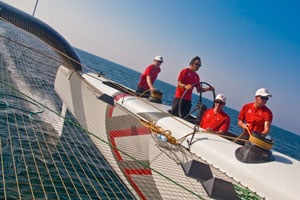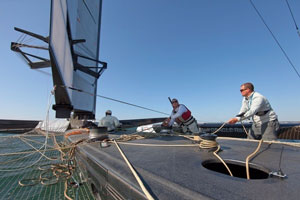
Gilles Martin-Raget/www.America’sCup.com| |Dennis Conner’s Cat runs away from Sir Michael Fay’s Dog in the 1988 America’s Cup, aka the Coma off Point Loma.| Twenty-two years ago, the America’s Cup was decided by a Deed of Gift mismatch between a 65-foot catamaran and a 90-foot monohull. They were each amazing yachts in their day, but the resulting races were boring parades of what were facetiously called The Cat and The Dog. But that was then. The speculation going into the 33rd America’s Cup, in contrast, is favorable to both boats, each having its strengths that might produce a horses-for-courses match. Talk from the teams tilts toward Alinghi 5 in lighter conditions, and USA in increased wind. Even if this is so, though, no one knows where the crossover is, above which windspeed does USA have an advantage. Furthermore, the differences between the competitors may show up not only in the strength of the wind, but also in downwind versus upwind performance.
Often in the America’s Cup the favored horse becomes apparent in the first five minutes of the first race. Don’t count on that this time. While you keep watching, with the advantage of helicopter coverage, here are some of the design details that you might spot.
BMW Oracle Racing had to target a broad bandwidth of performance in its challenger, because Alinghi would make the choice of venue, and, hence, have some control over anticipated wind conditions. Alinghi initially chose a light air venue in the United Arab Emirates. That venue was ruled to be contrary to the Deed of Gift, leaving either a southern hemisphere venue for the February match, or Valencia if both teams agreed. So here we are in Valencia in the winter, with the wind varying significantly from day to day, and Alinghi no doubt hoping to be blessed with light air on the 8th and 10th.
In virtually any sailboat design, stability buys sail-carrying power, and sail power buys speed. Stability in multihulls comes primarily from the distance from the athwartships center of weight to the leeward hull-true of a proa, a catamaran or a trimaran. Subject to diminishing returns of construction weight, more beam is good. Both of the AC33 multihulls have chosen essentially square proportions of overall breadth to waterline length, and both sail on just one hull in all but the lightest winds-USA taking a bit more wind to fly its center hull. Sailing on one hull minimizes hydrodynamic drag by having less wetted surface on one hull carrying the boat’s weight than when it’s shared by two hulls.
Another subtle contributor to stability is the curved daggerboards. The leeward board produces not only horizontal force in the normal way to counteract the side force of the sails, but also a vertical component that, effectively, pushes up on the leeward hull. This has the same effect as prying down on the windward hull-like hiking or sitting on the weather rail.
Weight is more damaging to resistance than it is helpful to stability. Consequently, there isn’t much on these boats that isn’t carbon fiber. An exception is water ballast, which is twice as far away from the leeward hull as the overall fixed weight of the boat, so it’s very effective in producing even greater righting moment, and can be jettisoned when not needed. Since both boats have been exploring just how much sail area they can pile on, they are both using water ballast.

Carlo Borlenghi/Alinghi **| |Alinghi 5 during training off Ras Al-Khaimah: From left to right, Peter Evans on the runner, Ernesto Bertarelli at the helm, Warwick Fleury on the mainsheet, and Pierre-Yves Jorand on the traveler. **| Not insignificant, also, is aerodynamic drag. When these boats are doing around 25 knots upwind in a pleasant 12 knots of true wind, they’re seeing around 35 knots of apparent wind across the deck and over the sails. In this much wind, aero drag becomes an equalizer in performance-their clean aerodynamic design is not there just for its looks. Both boats have experimented with lightweight fairings extending aft of the crossbeams; we’ll see on race day what their tech juries have decided about them. USA has gone to the extreme of eliminating all but a few strategic vestiges of its trampoline to reduce drag. It’s turned the sailors into acrobats as they traverse the boat for tacking and sail handling along the narrow crossbeams. Alinghi’s increased need to move crew across the full breadth of the boat makes her trampoline more essential.
The helmsman has a long hike across the boat after tacking or jibing while an alternate helmsman takes the con for a short time. Look for Ernesto Berterelli himself as Alinghi 5’s primary helmsman, with French multihull master Loick Peyron as his second. James Spithill rides the very exposed-looking helm platform on USA, with John Kostecki covering the transfer when tacking. Since James is frequently facing 30- to 40-knot apparent winds as he balances on his perch, it’s a good thing he has a wheel to hold onto.
A pair of massively strong crossbeams connects each boat’s hulls. The forward beam carries the mast compression loading from the windward shroud (side stay), pushing down, while the leeward hull is pushing up from the beam’s other end. The aft beam carries the very highly loaded mainsheet, as well as the upward load of the leeward hull against the boat’s weight. Both beams have to resist large torsional loads, as well, from such things as the running backstays and burying the leeward bow in a wave. USA’s shrouds are set well aft on the outboard hulls, imparting very high upward load far aft; additional running backstays are inboard on the main beam. Alinghi 5’s shrouds attach to the hulls about midway between crossbeams, with its runners near centerline on her aft beam. Notice a pair of diagonal compression struts on Alinghi 5 that connect from the reacher sheeting points to the mast step, part of the boat’s clever truss system.
The aft beam carries some primary systems, too. Both boats have steering linkages connecting the port and starboard rudders and wheels. There are traveler controls for the mainsheet and reacher, and a few other devices. They also carry the engine for the powered hydraulic system used to trim the sails, cant the rig, and take on or transfer ballast water pumps. Given the huge loads on the sheets and halyards, as well as water pumping requirements, this was a controversial but eminently practical alternative to a large team of grinders for the sole purpose of muscle power. It leaves no shortage of demands on highly skilled and intelligent professional sailors to control all aspects of operating these speed machines.

Gilles Martin-Raget/BMW Oracle Racing| |**Dirk de Ridder controls the angle of attack of the wing with the line in his hand, similar to the traveler on a soft sail. The wings shape is adjusted via a series of hydraulic controls. **| The event’s video coverage will give views of the deck and down the sails/wing that few have seen before. There is significant wind gradient from near the deck to 200 feet off the water, so sails will have to be set with twist. Port and starboard wind instruments mounted outboard on the aft crossbeam give clear readings on the windward side near the normal 10-meter reference height, to compare with the masthead readings at 60 meters-plus.
Alinghi 5’s mainsail has a broad girth at the head for greatest power and efficiency, but its twist has to be controlled by leech tension. USA’s wing has two fore-and-aft elements, with nine separate segments vertically in the aft element. This gives quite a lot of control over camber and twist. As the wind builds, the main elements can be de-cambered and the upper segments twisted off as needed, doing so with positive control. When tacking, there is no mainsail flogging, and the wing can quickly be put into optimum settings for accelerating. This is all done with relatively light loads on the control system.
These boats are extremely close-winded. Their blade jibs barely overlap the mast or wing at deck level, and leave an open slot over most of the leech. Where to sheet them is a limiting design issue on Alinghi 5, especially, since there’s no deck aft of its forward crossbeam. There is an arrangement to lead the jib sheet somewhat aft of the beam, but it hasn’t been clear to me what it is. USA is able to trim its jib to its deck.
When sailing their jibe angles downwind, these very efficient craft bring the apparent wind way forward. Huge, relatively flat reachers (Code 0’s) extend from the tip of the bowsprit to near the aft beam, to which they sheet. The jib and reacher are on large furling drums and have integral luff stays.
At the right camera angles, you might see the rigs canted to windward. This is primarily to maintain the maximum vertical span of the airfoil for best windward effectiveness. It also reduces or eliminates a heeled rig’s downward aero component, whose force acts like added weight. At the same time, it shifts the rig’s weight to windward, as another form of moveable ballast.
Among some unconventional sailing gear you’ll see are intercom headsets to deal with the distances and wind noise on these boats. Also, you might see knit hats. It’s wintertime here, with temperatures that can be in the 40s before wind chill.
Whether you’re watching the video or just reading about the races, try to appreciate the power and speed of Alinghi 5 and USA, the talent and focus of each member of their select crews, the genius of their design teams, the skill of their shore teams, and the spectacular pair of racing machines that their huge efforts have brought to America’s Cup 33. Both teams deserve our respect and applause.









